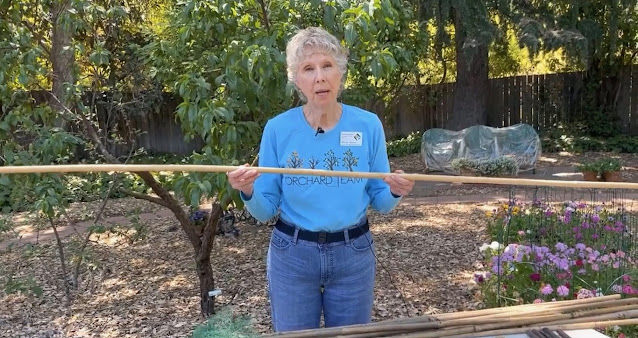
Master gardeners talk fruit protection, straw bales and more

|
|
UCCE master gardener Wendy Wilson explains the simple tools needed to net a fruit tree. (Screengrab from Sacramento County master gardeners YouTube channel)
|
Have you checked out the Sacramento County master gardeners' YouTube channel lately? Four new videos have been added to the 30 already there. They each tackle an important gardening question for this time of year
1) Netting Fruit Trees: An Easy and Inexpensive Method. Are the birds and squirrels eyeing your ripening tree crop? Master gardener Wendy Wilson demonstrates how to protect the fruit, on a 7-foot-tall cherry tree. (The master gardener Orchard Team recommends keeping fruit trees to this height for ease of picking and maintenance.)
2) Straw Bale Gardening, Part 1: Preparing the Bales. Master gardener Gail Pothour has been setting up straw bale gardens at the Fair Oaks Horticulture Center for a number of years, growing everything from sweet potatoes to tomatoes in them. She takes viewers through the process of conditioning the straw bales. Great information on the difference between hay and straw, too. Here's the printed guide she mentions in the video. A second video is planned on planting and growing in the bales.
3) Blueberries: Amending Your Soil's pH. Blueberries are picky about their soil -- they need a pH level of 4.5 to 5.5, which is acidic. Master gardener Marta Kravech explains why and how to get the soil acidic enough for blueberries to perform their best.
4) Maintaining a Weed-Free Lawn. Master gardener Sherry Dunn discusses the most common lawn weeds, plus offers mowing tips and information on herbicides.
The previously posted master gardener videos on YouTube contain a wealth of gardening tips. Here are 3 that are relevant right now:
-- Thinning Fruit on Your Fruit Trees. Thinning keeps fruit trees healthy and prevents breakage of limbs.
-- What's Wrong With My Tomatoes? This video tackles environmental disorders such as catfacing, blossom end rot, cracking and sunscald.
-- Harvest and Rejuvenate Your Lavender. Ruth Ostroff and Vivian Sellers of the master gardeners' Herb Team show the best way to keep lavender healthy.
-- Kathy Morrison
Comments
0 comments have been posted.Sacramento Digs Gardening to your inbox.
Sites We Like
Garden Checklist for week of April 14
It's still not warm enough to transplant tomatoes directly in the ground, but we’re getting there.
* April is the last chance to plant citrus trees such as dwarf orange, lemon and kumquat. These trees also look good in landscaping and provide fresh fruit in winter.
* Smell orange blossoms? Feed citrus trees with a low dose of balanced fertilizer (such as 10-10-10) during bloom to help set fruit. Keep an eye out for ants.
* Apply slow-release fertilizer to the lawn.
* Thoroughly clean debris from the bottom of outdoor ponds or fountains.
* Spring brings a flush of rapid growth, and that means your garden needs nutrients. Fertilize shrubs and trees with a slow-release fertilizer. Or mulch with a 1-inch layer of compost.
* Azaleas and camellias looking a little yellow? If leaves are turning yellow between the veins, give them a boost with chelated iron.
* Trim dead flowers but not leaves from spring-flowering bulbs such as daffodils and tulips. Those leaves gather energy to create next year's flowers. Also, give the bulbs a fertilizer boost after bloom.
* Pinch chrysanthemums back to 12 inches for fall flowers. Cut old stems to the ground.
* Mulch around plants to conserve moisture and control weeds.
* From seed, plant beans, beets, cantaloupes, carrots, corn, cucumbers, melons, radishes and squash.
* Plant onion sets.
* In the flower garden, plant seeds for asters, cosmos, celosia, marigolds, salvia, sunflowers and zinnias.
* Transplant petunias, zinnias, geraniums and other summer bloomers.
* Plant perennials and dahlia tubers for summer bloom.
* Mid to late April is about the last chance to plant summer bulbs, such as gladiolus and tuberous begonias.
* Transplant lettuce seedlings. Choose varieties that mature quickly such as loose leaf.